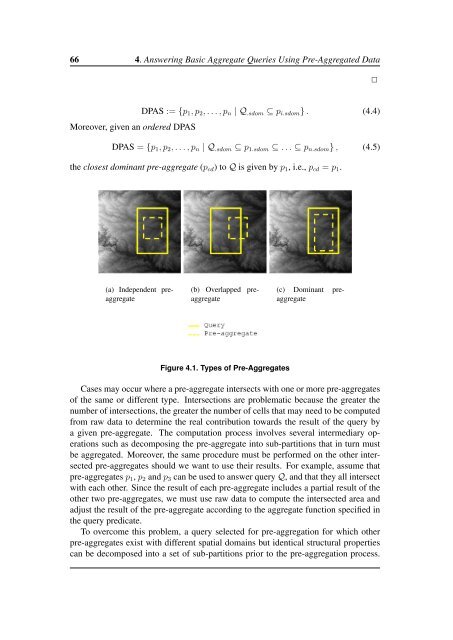Applying OLAP Pre-Aggregation Techniques to ... - Jacobs University
Applying OLAP Pre-Aggregation Techniques to ... - Jacobs University
Applying OLAP Pre-Aggregation Techniques to ... - Jacobs University
You also want an ePaper? Increase the reach of your titles
YUMPU automatically turns print PDFs into web optimized ePapers that Google loves.
66 4. Answering Basic Aggregate Queries Using <strong>Pre</strong>-Aggregated Data<br />
✷<br />
DPAS := {p 1 , p 2 , . . . , p n | Q .sdom ⊆ p i.sdom } . (4.4)<br />
Moreover, given an ordered DPAS<br />
DPAS = {p 1 , p 2 , . . . , p n | Q .sdom ⊆ p 1.sdom ⊆ . . . ⊆ p n.sdom } , (4.5)<br />
the closest dominant pre-aggregate (p cd ) <strong>to</strong> Q is given by p 1 , i.e., p cd = p 1 .<br />
(a) Independent preaggregate<br />
(b) Overlapped preaggregate<br />
(c) Dominant preaggregate<br />
Figure 4.1. Types of <strong>Pre</strong>-Aggregates<br />
Cases may occur where a pre-aggregate intersects with one or more pre-aggregates<br />
of the same or different type. Intersections are problematic because the greater the<br />
number of intersections, the greater the number of cells that may need <strong>to</strong> be computed<br />
from raw data <strong>to</strong> determine the real contribution <strong>to</strong>wards the result of the query by<br />
a given pre-aggregate. The computation process involves several intermediary operations<br />
such as decomposing the pre-aggregate in<strong>to</strong> sub-partitions that in turn must<br />
be aggregated. Moreover, the same procedure must be performed on the other intersected<br />
pre-aggregates should we want <strong>to</strong> use their results. For example, assume that<br />
pre-aggregates p 1 , p 2 and p 3 can be used <strong>to</strong> answer query Q, and that they all intersect<br />
with each other. Since the result of each pre-aggregate includes a partial result of the<br />
other two pre-aggregates, we must use raw data <strong>to</strong> compute the intersected area and<br />
adjust the result of the pre-aggregate according <strong>to</strong> the aggregate function specified in<br />
the query predicate.<br />
To overcome this problem, a query selected for pre-aggregation for which other<br />
pre-aggregates exist with different spatial domains but identical structural properties<br />
can be decomposed in<strong>to</strong> a set of sub-partitions prior <strong>to</strong> the pre-aggregation process.
















